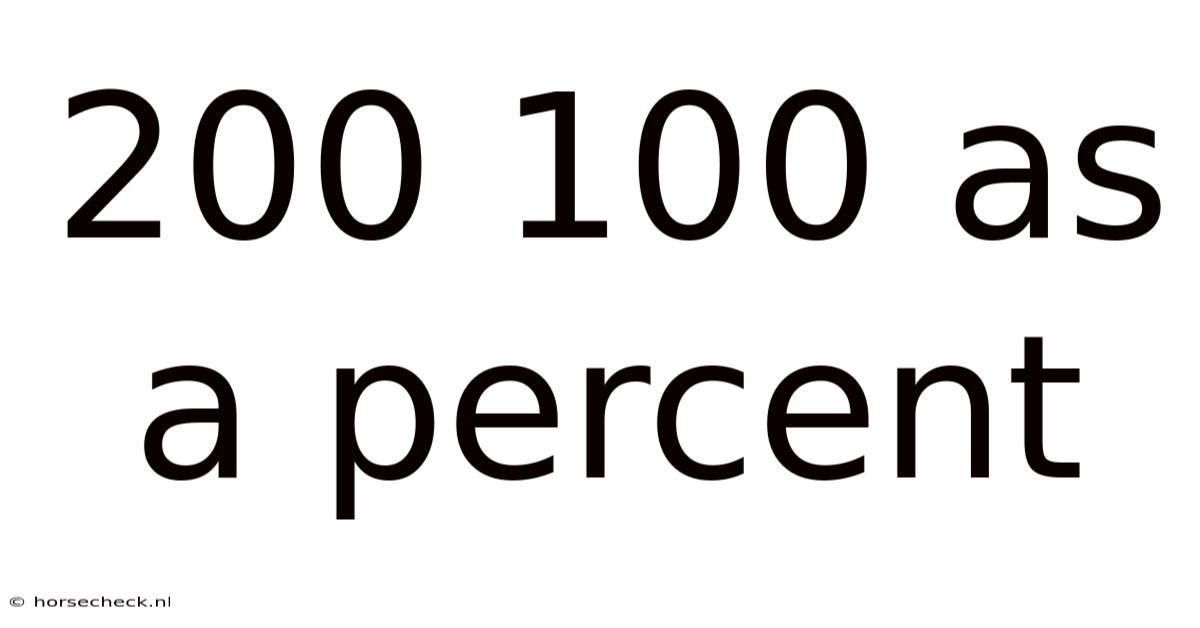200 100 As A Percent
horsecheck
Sep 23, 2025 · 4 min read

Table of Contents
200/100 as a Percent: Understanding Ratios and Percentages
Understanding how to express ratios as percentages is a fundamental skill in mathematics with applications across numerous fields, from finance and statistics to everyday life. This article delves into the concept of representing the ratio 200/100 as a percentage, explaining the process step-by-step and exploring the broader implications of percentage calculations. We will not only calculate the percentage but also delve into the underlying principles, offering practical examples and addressing common questions.
Introduction: What is a Percentage?
A percentage is a way of expressing a number as a fraction of 100. The word "percent" itself comes from the Latin "per centum," meaning "out of a hundred." Percentages are used extensively to represent proportions, changes, and rates. For instance, a 10% discount means a reduction of 10 units for every 100 units. This seemingly simple concept forms the basis of many complex calculations.
Calculating 200/100 as a Percentage: A Step-by-Step Guide
The process of converting a fraction to a percentage is straightforward. The ratio 200/100 represents 200 parts out of 100 parts. To express this as a percentage, we follow these steps:
-
Divide the numerator by the denominator: In this case, we divide 200 by 100: 200 ÷ 100 = 2
-
Multiply the result by 100: This step converts the decimal value into a percentage. 2 x 100 = 200
-
Add the percent symbol (%): This signifies that the number represents a percentage. Therefore, 200/100 = 200%
Therefore, 200/100 expressed as a percentage is 200%.
Understanding the Result: What Does 200% Mean?
A percentage greater than 100% indicates that the numerator is larger than the denominator. In this specific instance, 200% signifies that the quantity represented by the numerator (200) is double the quantity represented by the denominator (100). It’s a value exceeding the base value by 100%, representing a 100% increase.
Real-World Applications of Percentages Greater Than 100%
Percentages exceeding 100% are not uncommon and have practical applications in various scenarios:
-
Financial Growth: If an investment grows from $100 to $200, it has increased by 100%. If it grows to $300, it’s a 200% increase relative to the initial investment.
-
Production Increase: If a factory produces 100 units one year and 200 units the next, production has increased by 200% (or doubled).
-
Population Growth: Population changes can often be represented by percentages exceeding 100%. If a town's population doubles, it signifies a 100% increase; tripling would be a 200% increase.
-
Data Analysis: In statistical analyses, values greater than 100% are possible, particularly when dealing with growth rates or comparing different datasets.
Percentage Calculations: Beyond 200/100
The method used to calculate 200/100 as a percentage applies to any fraction. To convert a fraction a/b to a percentage, follow these steps:
-
Divide a by b.
-
Multiply the result by 100.
-
Add the % symbol.
Illustrative Examples: Applying Percentage Calculations
Let's consider a few more examples to solidify our understanding:
-
Example 1: Convert the fraction 50/25 to a percentage.
- 50 ÷ 25 = 2
- 2 x 100 = 200
- Therefore, 50/25 = 200%
-
Example 2: Convert the fraction 15/75 to a percentage.
- 15 ÷ 75 = 0.2
- 0.2 x 100 = 20
- Therefore, 15/75 = 20%
-
Example 3: Convert the fraction 300/150 to a percentage.
- 300 ÷ 150 = 2
- 2 x 100 = 200
- Therefore, 300/150 = 200%
Scientific Explanation: Ratios and Proportions
At its core, the conversion of a fraction to a percentage is a manipulation of ratios and proportions. A ratio is a comparison of two numbers, often expressed as a fraction. A proportion is a statement that equates two ratios. When we convert a fraction to a percentage, we are essentially expressing the ratio as a proportion where the denominator is 100.
Frequently Asked Questions (FAQ)
Q1: What if the denominator is zero?
A1: Division by zero is undefined in mathematics. You cannot calculate a percentage if the denominator is zero.
Q2: Can percentages be negative?
A2: Yes, percentages can be negative, usually representing a decrease or loss. For example, a -10% change indicates a decrease of 10%.
Q3: How do I calculate percentage change?
A3: Percentage change is calculated using the formula: [(New Value - Old Value) / Old Value] x 100%.
Q4: How do I calculate percentage increase or decrease?
A4: Percentage increase: [(New Value - Original Value) / Original Value] x 100% Percentage decrease: [(Original Value - New Value) / Original Value] x 100%
Conclusion: Mastering Percentages
Understanding how to express ratios as percentages is a vital mathematical skill with widespread applications. While the process of converting a fraction to a percentage might seem simple, its implications are far-reaching. From analyzing financial data and understanding population growth to making everyday decisions, the ability to calculate and interpret percentages is an invaluable tool. This article provided a detailed walkthrough of converting 200/100 to a percentage (200%), along with illustrative examples and explanations, equipping you with a firm grasp of this fundamental concept. Remember that mastering percentage calculations involves not just the mechanical process but also a clear understanding of what the results signify in various contexts.
Latest Posts
Latest Posts
-
45 Degrees C In F
Sep 23, 2025
-
79 8 As A Mixed Number
Sep 23, 2025
-
2 7 8 As Decimal
Sep 23, 2025
-
Lcm Of 4 And 16
Sep 23, 2025
-
What Is 2 3 Of 60
Sep 23, 2025
Related Post
Thank you for visiting our website which covers about 200 100 As A Percent . We hope the information provided has been useful to you. Feel free to contact us if you have any questions or need further assistance. See you next time and don't miss to bookmark.